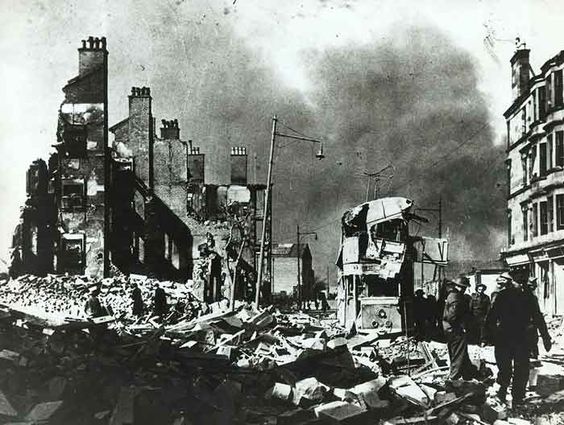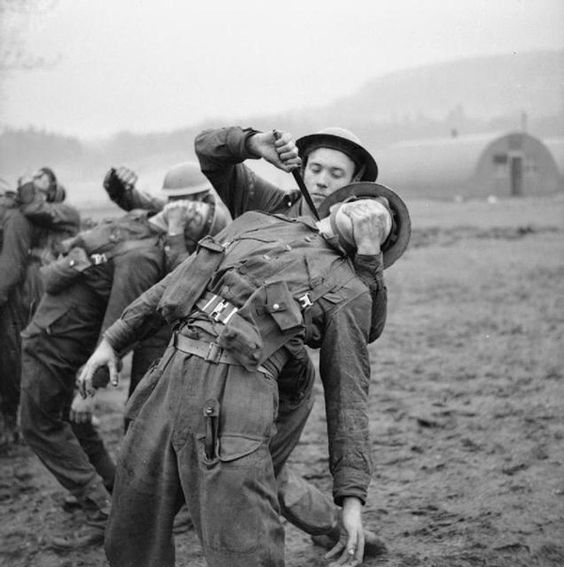Thursday 20 March 1941
 |
| "Their Majesties being greeted by the C in C, Admiral Sir Martin E Dunbar-Nasmith, VC, KCB." This is at Plymouth on 20 March 1940. © IWM (A 3481). |
Italian/Greek Campaign: The desultory Italian Primavera Offensive continues today without any progress on 20 March 1941. Italian 11th Army attacks the Greek Epirus Army near Klisura. Meanwhile, Operation Lustre, the British reinforcement of Greece to oppose an expected German invasion, continues. The Tommies take up positions on the Aliakmon Line facing Bulgaria.
East African Campaign: The British at Keren make one last attempt to clear the Dongolaas Gorge in order to ram a column through it despite strong Italian defensive positions. The attempt fails, with the British taking 19 casualties, and a later attempt with two I tanks also fails. After this, the British spend their time repositioning their forces for flank attacks on the gorge, so ground activity is light. However, RAF and South African RAF planes bomb the Italian positions in the hills that overlook the key Dongolaas Gorge.
British forces to the south are proceeding practically unimpeded. The British troops that landed at Berbera make more good ground and link up with the 11th African Division at Hargeisa. That said... the ground being occupied in this region is largely worthless - only the ports and major cities have any strategic value, and that only slight.
European Air Operations: The King and Queen have been on a tour of Wales and southern England to boost morale. Yesterday, they were at Swansea, and today the royals visit Plymouth. It is a standard visit, and around dusk, the King and Queen depart at 18:00 on their private train. As they are at the station, the air raid sirens sound. The royals continue on to their next destination without incident, but many other important personages remain behind. The actual raid by 125 bombers begins around 20:30, and the VIPs adjourn to basements. It is an unusually heavy raid, destroying the center of town and sinking:
Some Luftwaffe bombers hit Bristol during the night, where visiting Australian Prime Minister Menzies is spending the night. He makes an interesting comment in his diary about how the RAF now can predict the location of attacks before they occur:
Battle of the Atlantic: German heavy cruisers Gneisenau and Scharnhorst are on their way to Brest at 23 knots. The British have numerous ships out looking for them, and they succeed: the ships are spotted by an airplane flying from HMS Ark Royal, which is part of Force H out of Gibraltar. Admiral Lütjens on board the Gneisenau is apprised of the RAF plane and alters course slightly to the north. During the day, the two Operation Berlin cruisers pass Norwegian tanker Polykarb, which Gneisenau captured on 15 March and is heading for the Gironde estuary with a prize crew.
While the Polykarb continues on its way unmolested, tankers Bianca (5688 tons) and San Casimiro (8046 tons), also captured by Gneisenau on the 15th, are not so lucky. The same aircraft that spots the cruisers also spots those two ships which are heading for France. Royal Navy battleship HMS Renown approaches the tankers, whose crews scuttle them. There are 46 Germans on the two ships taken as prisoners.
U-106 (Kptlt. Jürgen Oesten) continues operating in the area north of the Cape Verde Islands and west of the African coast where it has been stalking Convoy SL-68. Today, late in the say at 23:23, U-106 launches two stern torpedoes at the convoy - basically potshots taken in poor light. One torpedo hits 31,100-ton Royal Navy battleship HMS Malaya on its port side, causing extensive damage and a list of 7 degrees. Malaya makes it to Trinidad, and then to the Brooklyn Navy Yard. Malaya thus beats damaged aircraft carrier HMS Illustrious to become the first Royal Navy ship repaired in a US shipyard during the war.
The other U-106 torpedo hist 7995-ton Dutch freighter Meerkerk. The Meerkerk also is damaged, but much less than Malaya. It sails back to Freetown, where it is under repair until late April 1941.
Royal Navy heavy cruiser HMS Norfolk returns to service after repairs to its damage from its April 1940 bombing. However, it still has some engine issues that need attention.
In a striking coincidence which may not actually be so coincidental - let's call it serendipitous instead - Royal Navy Minesweeping trawlers HMS Juliet and Romeo are commissioned and launched, respectively, while HMCS Truro and Digby are laid down.
The Luftwaffe sinks 21-ton Royal Navy fishing boat HMT Gloaming and 25-ton fishing boat Joan Margaret off the Humber. There are five deaths.
The Luftwaffe sinks 1386-ton Polish freighter Cieszyn a few miles off Manacle Point. Everyone survives.
The Luftwaffe indirectly sinks 174-ton British trawler Bianca in the Irish Sea (this Bianca is different than tanker Biance that is scuttled today in the Bay of Biscay). Bianca is dragging its net as usual when it has an unwelcome catch - a Luftwaffe bomb or aerial mine. There are five deaths.
Royal Navy 72-ton drifter HMT Soizic is lost in action, perhaps due to a mine or Luftwaffe attack.
The Luftwaffe bombs and damages 40-ton tug Charlight at Milwall.
RAF Coastal Command bombs and sinks 7500-ton Sperrbrecher-12 (minesweeper) Stolzenfels in the North Sea off Ameland, Friesland.
Convoy OB 300 departs from Liverpool, Convoy SC 26 departs from Halifax.
Three Royal Navy destroyers (HMS Intrepid, Icarus and Impulsive) lay minefield GU in the English Channel.
U-562 (Oberleutnant zur See Herwig Collmann) is commissioned.
Battle of the Mediterranean: Troops continue to arrive in Tripoli. Among the men arriving today are members of a medium tank battalion of the Ariete Division. The local commanders send OKH (the German army command) an assessment of the strategic situation late in the day which places the German line as follow:
The Royal Navy has begun another elaborate supply operation to Malta. The Admiralty instructs Admiral Cunningham, Commander-in-chief of the Mediterranean Fleet, to assist aircraft carrier HMS Argus to deliver a dozen Hurricanes and two Skuas to the embattled island. As per standard practice, the Hurricanes will fly off in two groups, each group led by a Skua.
Operation Compass was a phenomenal success for the British. However, it is still easy to overstate this success. While the British removed the Italians from Egypt and took several key Italian ports and bases, they still only occupied a thin coastal slice of Libya. On 20 March 1941, Australian 2/9th soldiers begin trying to expand this strip of occupied land to the south, attacking Giarabub (Jarabub) Oasis, located about 225 km (140 miles) to the south of Bardia. The Germans set aside two Junkers Ju 88 bombers for support against the attacks.
Lieutenant General Erwin Rommel becomes the 10th person in the Wehrmacht to receive the Oak Leaves to his Knight's Cross.
There is a resumption of invasion jitters on Malta. "Sources" suggest that Germans are accumulating flat-bottomed landing craft in Sicily. However, this time the rumors have a unique twist: rather than the main island of Malta, the target is said to be Gozo, the second-largest island in the group just to the northwest. The Royal Army begins preparing defenses on Gozo, which apparently has been undefended until now.
Convoy BN 22 departs from Bombay bound for Suez.
US/Australian Relations: The cruiser squadron (USS Chicago and Portland) under the command of Vice-Admiral John H Newton, Jr, Commander, Cruisers, Scouting Force, Pacific Fleet, arrives in Sydney Harbor. The government in Canberra has adjourned so that the ministers can watch the arrival and subsequent parade. While little-noted on the US side, the arrival is feted by the Australian press and it is a watershed moment in US/Australian relations. An estimated half-million Australians watch the fleet arrive. Tellingly, the event completely overshadows the arrival of the first Japanese ambassador, Tatsuo Kawai, to Australia on the 19th. The fleet's arrival is recounted in an official government summary:
After the parade, there is a luncheon for the US sailors at the Sydney Town Hall. Later, there is a dinner at which Acting Prime Minister Arthur Fadden toasts "our guests" and noted that this visit "signified a new and higher plane of friendship" between the two countries."
US/New Zealand Relations: Captain Ellis S. Stone and his TG 9.2 cruiser squadron departs from Auckland, New Zealand after a three-day visit. They proceed toward Tahiti.
US/Soviet Relations: Acting Secretary of State Sumner Welles meets privately with Soviet Ambassador Konstantin Umansky and reiterates his previous statements that Germany is planning to invade the USSR. Welles' source, which he cannot reveal, is top secret decrypts of Japanese coded transmissions to and from Baron Oshima, the Japanese ambassador to Germany. It is unclear if the Americans decoded these, or the British - for the British cracked the Japanese diplomatic code some time ago. See below for the beginnings of Japanese recognition that at least some of their codes have been broken.
US/Anglo Relations: The United States quickly takes up Winston Churchill's suggestion that interned Italian and German vessels in US ports be put to some kind of use. The US Coast Guard begins surveying these ships and finds some evidence of sabotage on an Italian ship being held at Wilmington, North Carolina. For the record, there are 28 Italian, 2 German and 35 Danish such vessels available. The US does not yet requisition these vessels, but the idea of doing so is being bruited about in the highest levels of the US government.
US/Japanese Relations: Japanese passenger ship Tatsuta Maru arrives at the port of San Francisco carrying Colonel Hideo Iwakuru. He is on a special mission from Prime Minister Hideki Tojo to repair diplomatic relations between the two countries.
Spy Stuff: The British have been reading the Japanese diplomatic codes, and the Americans also have broken some of their codes. Japanese Ambassador to the US Admiral Nomura Kichisaburo sends a message to the Foreign Ministry:
Prince Paul takes some direct action, too. In a murky incident, he hands over Premier Milan Stoyadinovich to the British, who will keep him in Cairo "for safekeeping." Stoyadinovich apparently has attempted to regain power with a much more pro-Axis agenda than Prince Paul. Some accounts state that British agents kidnap Stoyadinovich, but press reports at the time suggest this was a voluntary move by the legitimate Yugoslav government.
US Military: Admiral Bloch, the commandant of the Fourteenth Naval District, replies to a 15 February 1941 letter from Admiral Stark concerning defenses at Pearl Harbor. Bloch notes that the depth of Pearl Harbor is 45 feet, which is far less than the minimum depth of 75 feet required for air-launched torpedoes. He agrees with Admiral Kimmel's previously expressed view that, for this reason, anti-torpedo baffles (nets) are unnecessary there. The Japanese, meanwhile, are well aware of the mechanics of air-launched torpedoes and are studying if these minimum depths can be made compatible with an attack on the US Fleet anchored at Pearl Harbor.
German Government: Reichsfuhrer SS Heinrich Himmler meets with his top cronies - including Rudolf Heß, Fritz Todt, and Reinhard Heydrich - and discusses plans for the future of soon-to-be-invaded eastern Europe. Along with this meeting, racial theorist Alfred Rosenberg becomes "Delegate for Central Planning for Questions of the Eastern European Area." Rosenberg has definite ideas about how captured territories in the East - those to be acquired during Operation Barbarossa - should be organized. This will involve organizational units called Reichskommissariats. This is not an original idea - Reichskommissariats are used in Norway, the Netherlands, Belgium, and France - but the ones in the East will cover vast tracts of land and be notorious for their exploitative agendas.
China: The Battle of Shanggao continues, but there is a lull in the battle. The Japanese retain a penetration into the first of three Chinese defensive lines. Both sides are bringing up reinforcements. There are some Japanese attacks near the Chin River at Szehsi and Kuanchiao.
German Homefront: The Propaganda Ministry's Reich Press Chief instructs his media outlets to highlight recent comments by Charles Lindbergh that the USAAC produces as many combat-ready planes as Germany produces every week. This actually is roughly true... now.
March 1941
March 1, 1941: Rettungsboje
March 2, 1941: Oath of Kufra
March 3, 1941: Germans in Bulgaria
March 4, 1941: Lofoten Islands Raid
March 5, 1941: Cooperation With Japan
March 6, 1941: Battle of Atlantic
March 7, 1941: Prien Goes Under
March 8, 1941: Cafe de Paris
March 9, 1941: Italian Spring Offensive
March 10, 1941: Humanitarian Aid
March 11, 1941: Lend Lease Becomes Law
March 12, 1941: A New Magna Carta
March 13, 1941: Clydeside Wrecked
March 14, 1941: Leeds Blitz
March 15, 1941: Cruisers Strike!
March 16, 1941: Kretschmer Attacks
March 17, 1941: Happy Time Ends
March 18, 1941: Woolton Pie
March 19, 1941: London Hit Hard
March 20, 1941: Romeo and Juliet
March 21, 1941: Plymouth Blitz
March 22, 1941: Grand Coulee Dam
March 23, 1941: Malta Under Siege
March 24, 1941: Afrika Korps Strikes!
March 25, 1941: Yugoslavia Joins The Party
March 26, 1941: Barchini Esplosivi
March 27, 1941: Belgrade Coup
March 28, 1941: Cape Matapan Battle
March 29, 1941: Lindbergh Rants
March 30, 1941: Commissar Order
March 31, 1941: Cookie Bombs
2020
East African Campaign: The British at Keren make one last attempt to clear the Dongolaas Gorge in order to ram a column through it despite strong Italian defensive positions. The attempt fails, with the British taking 19 casualties, and a later attempt with two I tanks also fails. After this, the British spend their time repositioning their forces for flank attacks on the gorge, so ground activity is light. However, RAF and South African RAF planes bomb the Italian positions in the hills that overlook the key Dongolaas Gorge.
British forces to the south are proceeding practically unimpeded. The British troops that landed at Berbera make more good ground and link up with the 11th African Division at Hargeisa. That said... the ground being occupied in this region is largely worthless - only the ports and major cities have any strategic value, and that only slight.
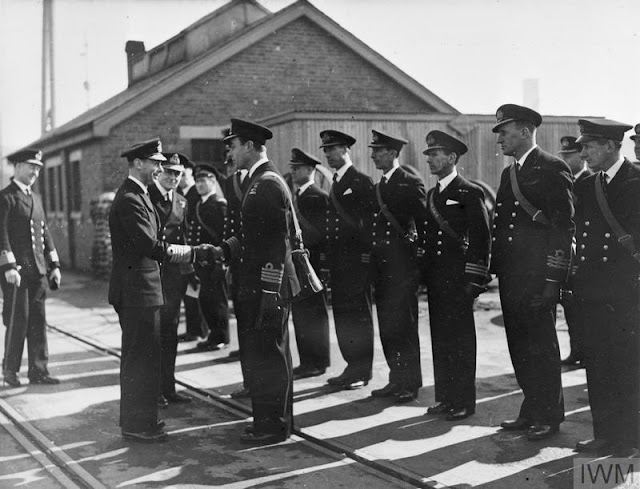 |
| "On his arrival at Flags Staff steps His Majesty was greeted by his cousin, Captain the Lord Louis Mountbatten, GCVO, DSO. His personal ADC." This is at Plymouth on 20 March 1940. © IWM (A 3485). |
- 338-ton Royal Navy tug HMT Sir Bevois
- 35-ton Royal Navy fishing vessel HMT Dox
- Hulk Mackay-Bennet (an old cable layer involved in the aftermath of the RMS Titanic sinking, later refloated and repaired)
- Tug Elan II (later refloated and repaired)
- 5248-ton British freighter Lindenhall (sunk at Victoria Dock, later refloated and repaired)
- 1395-ton British freighter Mari II (later refloated and repaired)
Some Luftwaffe bombers hit Bristol during the night, where visiting Australian Prime Minister Menzies is spending the night. He makes an interesting comment in his diary about how the RAF now can predict the location of attacks before they occur:
Air raid warnings from London. They study beams from Germany, and where they cross is the place. Loud noises from the city after dinner, but we talk, as usual, until midnight.A small force of three Manchester bombers attacks the U-boat pens at Lorient. One of the bombers has an engine fire which quickly consumes the aircraft. The pilot and crewman Charles Leonard Wheatley try to bring the plane home, but it hits a tree and crashes. Wheatley survives the crash and, knowing that the fire might set off the plane's bombs, successfully fights the fire at close range. He will receive the George Medal for this. RAF Bomber Command also sends 42 aircraft on minelaying operations along routes used by U-boats to and from bases in the Bay of Biscay (Brest, Lorient, and St. Nazaire).
 |
| "HM The King inspecting an Indian contingent paraded in the grounds of Admiralty House." This is at Plymouth, 20 March 1941. © IWM (A 3497). |
While the Polykarb continues on its way unmolested, tankers Bianca (5688 tons) and San Casimiro (8046 tons), also captured by Gneisenau on the 15th, are not so lucky. The same aircraft that spots the cruisers also spots those two ships which are heading for France. Royal Navy battleship HMS Renown approaches the tankers, whose crews scuttle them. There are 46 Germans on the two ships taken as prisoners.
U-106 (Kptlt. Jürgen Oesten) continues operating in the area north of the Cape Verde Islands and west of the African coast where it has been stalking Convoy SL-68. Today, late in the say at 23:23, U-106 launches two stern torpedoes at the convoy - basically potshots taken in poor light. One torpedo hits 31,100-ton Royal Navy battleship HMS Malaya on its port side, causing extensive damage and a list of 7 degrees. Malaya makes it to Trinidad, and then to the Brooklyn Navy Yard. Malaya thus beats damaged aircraft carrier HMS Illustrious to become the first Royal Navy ship repaired in a US shipyard during the war.
The other U-106 torpedo hist 7995-ton Dutch freighter Meerkerk. The Meerkerk also is damaged, but much less than Malaya. It sails back to Freetown, where it is under repair until late April 1941.
Royal Navy heavy cruiser HMS Norfolk returns to service after repairs to its damage from its April 1940 bombing. However, it still has some engine issues that need attention.
In a striking coincidence which may not actually be so coincidental - let's call it serendipitous instead - Royal Navy Minesweeping trawlers HMS Juliet and Romeo are commissioned and launched, respectively, while HMCS Truro and Digby are laid down.
The Luftwaffe sinks 21-ton Royal Navy fishing boat HMT Gloaming and 25-ton fishing boat Joan Margaret off the Humber. There are five deaths.
The Luftwaffe sinks 1386-ton Polish freighter Cieszyn a few miles off Manacle Point. Everyone survives.
The Luftwaffe indirectly sinks 174-ton British trawler Bianca in the Irish Sea (this Bianca is different than tanker Biance that is scuttled today in the Bay of Biscay). Bianca is dragging its net as usual when it has an unwelcome catch - a Luftwaffe bomb or aerial mine. There are five deaths.
Royal Navy 72-ton drifter HMT Soizic is lost in action, perhaps due to a mine or Luftwaffe attack.
The Luftwaffe bombs and damages 40-ton tug Charlight at Milwall.
RAF Coastal Command bombs and sinks 7500-ton Sperrbrecher-12 (minesweeper) Stolzenfels in the North Sea off Ameland, Friesland.
Convoy OB 300 departs from Liverpool, Convoy SC 26 departs from Halifax.
Three Royal Navy destroyers (HMS Intrepid, Icarus and Impulsive) lay minefield GU in the English Channel.
U-562 (Oberleutnant zur See Herwig Collmann) is commissioned.
 |
| HMS Malaya (Maritime Quest). |
Forward forces still southwest of Agedabia. Defensive line Mersa el Brega (security patrols at Bescer) – southern tip Sebeha es Seghira and mobile tank security at Uadi Faregh from Bettafal to Ain en Naga, security in Haselat, reserves around Bilal, Gtafia.Tentatively, the Germans plan to launch an offensive to take Mersa el Brega and then Gialo with battalion troops stationed at Marada (Major Appel commanding). The Germans request that the Italian Commando Supremo set aside troops to guard the rear, flanks, and gaps of any offensives.
The Royal Navy has begun another elaborate supply operation to Malta. The Admiralty instructs Admiral Cunningham, Commander-in-chief of the Mediterranean Fleet, to assist aircraft carrier HMS Argus to deliver a dozen Hurricanes and two Skuas to the embattled island. As per standard practice, the Hurricanes will fly off in two groups, each group led by a Skua.
Operation Compass was a phenomenal success for the British. However, it is still easy to overstate this success. While the British removed the Italians from Egypt and took several key Italian ports and bases, they still only occupied a thin coastal slice of Libya. On 20 March 1941, Australian 2/9th soldiers begin trying to expand this strip of occupied land to the south, attacking Giarabub (Jarabub) Oasis, located about 225 km (140 miles) to the south of Bardia. The Germans set aside two Junkers Ju 88 bombers for support against the attacks.
Lieutenant General Erwin Rommel becomes the 10th person in the Wehrmacht to receive the Oak Leaves to his Knight's Cross.
There is a resumption of invasion jitters on Malta. "Sources" suggest that Germans are accumulating flat-bottomed landing craft in Sicily. However, this time the rumors have a unique twist: rather than the main island of Malta, the target is said to be Gozo, the second-largest island in the group just to the northwest. The Royal Army begins preparing defenses on Gozo, which apparently has been undefended until now.
Convoy BN 22 departs from Bombay bound for Suez.
 |
| "HM The Queen talking to girls who work in the dockyard." This is at Plymouth on 20 March 1941. © IWM (A 3484). |
Owing to misty rain the entry of the detachment into the harbour, originally scheduled for 8 a.m., was delayed until about 8:45 a.m. A salute of 21 guns was accorded to the ships as they passed the Heads, and public enthusiasm expressed itself in the hooting of sirens and motor horns and the cheering of the dense crowds lining the foreshore as the detachment proceeded up the Harbour."Visit of United States Naval Detachment to Sydney and Brisbane - March 1941," National Archives of Australia: A981, War S23.
After the parade, there is a luncheon for the US sailors at the Sydney Town Hall. Later, there is a dinner at which Acting Prime Minister Arthur Fadden toasts "our guests" and noted that this visit "signified a new and higher plane of friendship" between the two countries."
US/New Zealand Relations: Captain Ellis S. Stone and his TG 9.2 cruiser squadron departs from Auckland, New Zealand after a three-day visit. They proceed toward Tahiti.
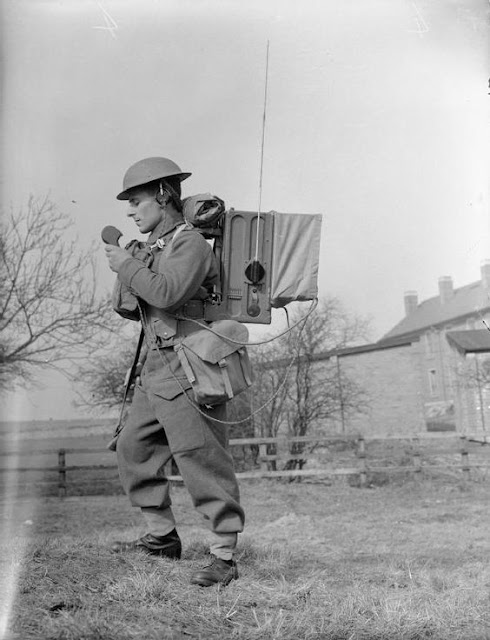 |
| An infantryman with a No.18 wireless set, Royal School of Signals. Catterick, 20 March 1941 (IWM COM 1126). |
US/Anglo Relations: The United States quickly takes up Winston Churchill's suggestion that interned Italian and German vessels in US ports be put to some kind of use. The US Coast Guard begins surveying these ships and finds some evidence of sabotage on an Italian ship being held at Wilmington, North Carolina. For the record, there are 28 Italian, 2 German and 35 Danish such vessels available. The US does not yet requisition these vessels, but the idea of doing so is being bruited about in the highest levels of the US government.
US/Japanese Relations: Japanese passenger ship Tatsuta Maru arrives at the port of San Francisco carrying Colonel Hideo Iwakuru. He is on a special mission from Prime Minister Hideki Tojo to repair diplomatic relations between the two countries.
Spy Stuff: The British have been reading the Japanese diplomatic codes, and the Americans also have broken some of their codes. Japanese Ambassador to the US Admiral Nomura Kichisaburo sends a message to the Foreign Ministry:
Though I do not know which ones, I have discovered that the United States is reading some of our codes. As for how I got the intelligence, I will inform you by courier or another safe way.Yugoslavia: Prince Paul meets with the Royal Council to discuss Adolf Hitler's ultimatum that Yugoslavia either joins the Tripartite Pact within the next few days or face the consequences. Prince Paul is ready to sign on the dotted line and gets a vote of 16-3 in favor of signing. However, there is extreme disagreement within the government and military about this path. In fact, disagreement about allying with the Germans within the Royal Council (and perhaps over Prince Paul's strongarm tactics in getting the outcome that he desires) causes four ministers to resign.
Prince Paul takes some direct action, too. In a murky incident, he hands over Premier Milan Stoyadinovich to the British, who will keep him in Cairo "for safekeeping." Stoyadinovich apparently has attempted to regain power with a much more pro-Axis agenda than Prince Paul. Some accounts state that British agents kidnap Stoyadinovich, but press reports at the time suggest this was a voluntary move by the legitimate Yugoslav government.
 |
| "4.5-inch anti-aircraft gun, Leeds, 20 March 1941." © IWM (H 8263). |
German Government: Reichsfuhrer SS Heinrich Himmler meets with his top cronies - including Rudolf Heß, Fritz Todt, and Reinhard Heydrich - and discusses plans for the future of soon-to-be-invaded eastern Europe. Along with this meeting, racial theorist Alfred Rosenberg becomes "Delegate for Central Planning for Questions of the Eastern European Area." Rosenberg has definite ideas about how captured territories in the East - those to be acquired during Operation Barbarossa - should be organized. This will involve organizational units called Reichskommissariats. This is not an original idea - Reichskommissariats are used in Norway, the Netherlands, Belgium, and France - but the ones in the East will cover vast tracts of land and be notorious for their exploitative agendas.
China: The Battle of Shanggao continues, but there is a lull in the battle. The Japanese retain a penetration into the first of three Chinese defensive lines. Both sides are bringing up reinforcements. There are some Japanese attacks near the Chin River at Szehsi and Kuanchiao.
German Homefront: The Propaganda Ministry's Reich Press Chief instructs his media outlets to highlight recent comments by Charles Lindbergh that the USAAC produces as many combat-ready planes as Germany produces every week. This actually is roughly true... now.
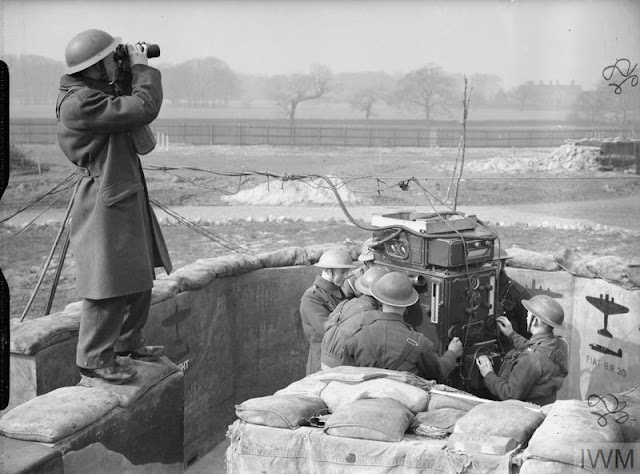 |
| "Spotter and predictor operators at a 4.5-inch anti-aircraft gun site in Leeds, 20 March 1941." © IWM (H 8271). |
March 1, 1941: Rettungsboje
March 2, 1941: Oath of Kufra
March 3, 1941: Germans in Bulgaria
March 4, 1941: Lofoten Islands Raid
March 5, 1941: Cooperation With Japan
March 6, 1941: Battle of Atlantic
March 7, 1941: Prien Goes Under
March 8, 1941: Cafe de Paris
March 9, 1941: Italian Spring Offensive
March 10, 1941: Humanitarian Aid
March 11, 1941: Lend Lease Becomes Law
March 12, 1941: A New Magna Carta
March 13, 1941: Clydeside Wrecked
March 14, 1941: Leeds Blitz
March 15, 1941: Cruisers Strike!
March 16, 1941: Kretschmer Attacks
March 17, 1941: Happy Time Ends
March 18, 1941: Woolton Pie
March 19, 1941: London Hit Hard
March 20, 1941: Romeo and Juliet
March 21, 1941: Plymouth Blitz
March 22, 1941: Grand Coulee Dam
March 23, 1941: Malta Under Siege
March 24, 1941: Afrika Korps Strikes!
March 25, 1941: Yugoslavia Joins The Party
March 26, 1941: Barchini Esplosivi
March 27, 1941: Belgrade Coup
March 28, 1941: Cape Matapan Battle
March 29, 1941: Lindbergh Rants
March 30, 1941: Commissar Order
March 31, 1941: Cookie Bombs
2020

